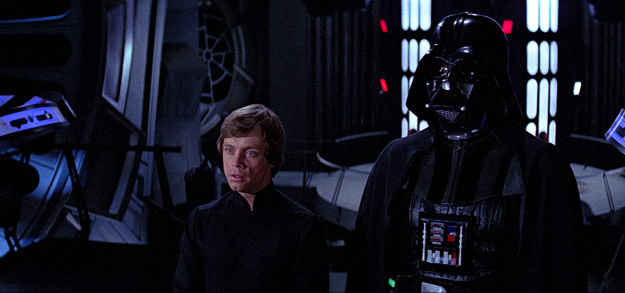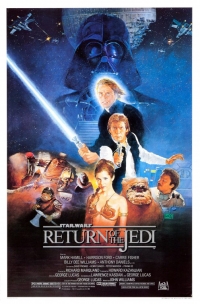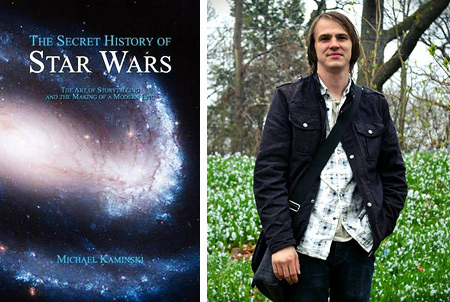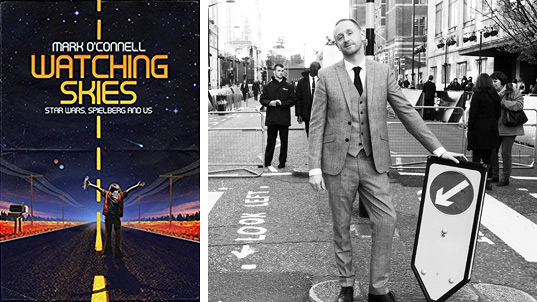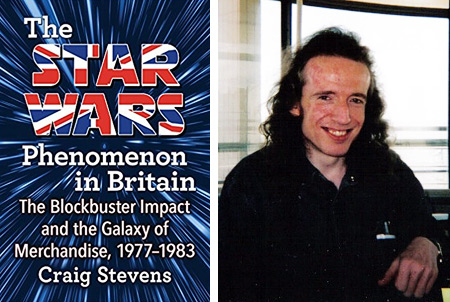THE Q&A
Michael Kaminski is the author of The Secret History of Star Wars: The Art of Storytelling and the Making of a Modern Epic (2008, Legacy).
Mark O’Connell is the author of Watching Skies: Star Wars, Spielberg and Us (2018, The History Press).
Craig Stevens is the author of The Star Wars Phenomenon in Britain: The Blockbuster Impact and the Galaxy of Merchandise, 1977-1983 (2018, McFarland).
The interviews were conducted separately and have been edited into a “roundtable” conversation format.
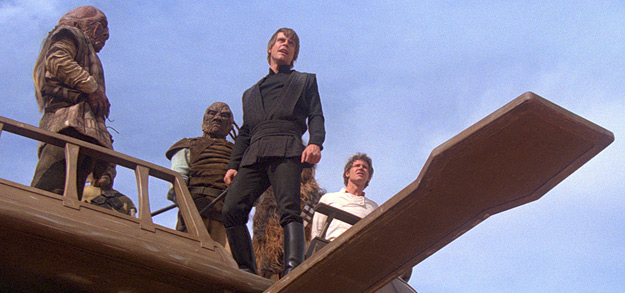
Michael Coate (The Digital Bits): How do you think Return of the Jedi should be remembered on its 35th anniversary?
Michael Kaminski: The 35th anniversary of Return of the Jedi comes just as Marvel Studios celebrates its 10th anniversary and the release of Infinity War, and I think there are a lot of parallels to be drawn in terms of bringing an ambitious, multi-film saga to a close. I struggle to think of a film series before the Star Wars trilogy which had a multi-movie storyline with the scale and scope that we ended up with in Return of the Jedi. Star Wars broke every box office record in history so of course sequels were going to be made, and we could have had another 10 years of 20th Century Fox cranking out a string of sequels to varying degree of success, and if you look at some of the early Expanded Universe like Splinter of the Mind’s Eye you get a window into this alternate world, but George Lucas took a different approach of making a three-film arc that told a larger tale. This is nothing special today, but before there was Marvel Studios or Harry Potter — which, it should also be noted, were simply adapting pre-existing literary works — Return of the Jedi did something truly unique by offering a satisfying capper to the story that began in 1977. Lucas also was ahead of his game in building in-roads to further the franchise, despite the finale of the third film — offering three more “prequels” set before the trilogy, and leaving the door open to continue the further adventures of the heroes or explore other areas of the world he had created in a cross-hatching “cinematic universe” before that term existed. It’s hard to see Return of the Jedi with fresh eyes and be truly staggered at the level of ambition and risk this approach had when the films were among the most popular and expensive ever made. Marvel Studios is getting massive accolades now as re-writing the book on franchise-building and world-building, but they are really just elaborating upon the example of the Star Wars series that only became apparent with the release of Empire Strikes Back and Return of the Jedi — really, a two-part expansion of Star Wars from a fairy tale into a saga, that didn’t just make more sequels but turned towards personal melodrama and a three-part epic, in something that wasn’t adapting pre-existing sources but being made in real-time as a wholly original tale exclusive to the cinema. Even though each entry has an “episode” number, what makes the two sequels unique is that they are decidedly not episodic, but instead the second and final acts of a classic three-act narrative structure. To do this with a fantasy epic set in space on such a large budget would still be impressive today, decades later. Given the landscape of Hollywood in the early 21st Century, Return of the Jedi is prophetic.
Yes, a huge part of the movie drags due to Ewoks, yes, the writing isn’t as clever as before, but Return of the Jedi, for all its flaws, was attempting something not done before. It was this film that we finally got “the trilogy,” still intoned with sacredness all these decades later.
I also think that Return of the Jedi stands as the crowning achievement of visual and special effects from the pre-digital era. Hand-painted mattes, models, puppets, and optical compositing reached a level of complexity and ingenuity that had never been seen before, and I would also say since. If anyone knows anything about optical compositing, the space battle over Endor is a masterclass of optical effects so mind-bogglingly complex, with its hundreds of layers and dizzying motion-tracked camera moves, that it can still compete with the best and most state-of-the-art action scenes of films made over 30 years later like Rogue One. It’s reasons like this that the history of cinema is being shortchanged with the original theatrical versions of these films not being released in new remasters.
Mark O’Connell: Instead of closing the lid on the Star Wars saga and despite its story finality, Return of the Jedi is one of the reasons the franchise continued cinematically. Admiral Ackbar, Mon Mothma, Emperor Palpatine, Nien Nunb, Wicket W. Warwick, Bib Fortuna, Jabba the Hutt, the Biker Scouts, the Ewoks and the Speeder Bikes are all last act ingredients which — instead of celebrating the final hurrah — create story worlds, audience enthusiasm, cool sidebar industries, and an adoration which fed into the momentum of post-1983 Star Wars. The diplomacy and political gravitas of Mon Mothma is all over the prequels, the Ackbar sense of commanding during battle is a major last act device of 2016’s Rogue One via Admiral Raddus, the alien gangster enclave of Jabba’s Palace reverberates in The Force Awakens, and the adventure and speed of the Speeder Bike chase has been furthered in every Podrace, Coruscant night chase, Geonosis pursuit and escape from Canto Bight since.
And aside from being the first Star Wars movie that is finally an all-out war in the stars, Return of the Jedi is also responsible for the first Episode VII and Episode VIII — in the guise of the sometimes-overlooked Ewok TV movies, Caravan of Courage (aka The Ewok Adventure, 1984) and The Battle for Endor (1985).
Craig Stevens: I think that it should be remembered as a fantastic addition to the Star Wars film saga that brought the original Star Wars trilogy to an exciting and satisfying conclusion. It introduced a host of fantastic characters and environments. People can think back to so many wonderful moments in the film, even if they haven’t seen it in years.
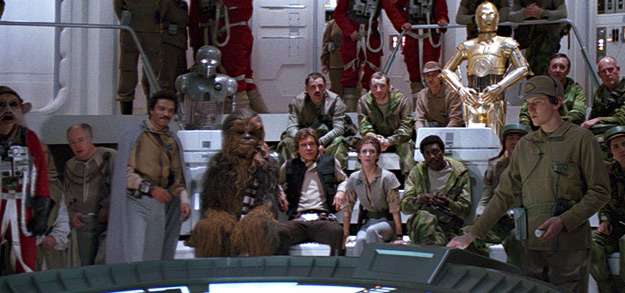
Coate: Can you recall the first time you saw Jedi?
Kaminski: I was too young to see the films in theaters, so the first time I saw it was from family friends taping it off of HBO for me in the mid-late 1980s, knowing that I liked the first two films so much. Return of the Jedi always bored me the most out of all the films when I was a child, and it still does. Star Wars was a lot of fun, and Empire Strikes Back just looked and felt so interesting, but even as a five-year-old Return of the Jedi never left the same impression on me. In fact, I taped over the first 25-minutes of my Return of the Jedi recording with an episode of Super Dave Osbourne around 1990 — nothing of note happened until Han comes out of the carbonite around the 25-minute mark anyway, right?
The main thing I watched it for as a kid were the scenes between Luke, Vader and the Emperor, and the space battle, and those continue to be the highlights for me as an adult. Over time, I have found the behind-the-scenes history and context that the film was made in to be as interesting as the film itself, which is the sort of stuff you tend to be oblivious to as a kid. I think I also became aware of the unevenness of the film, having both the best and worst scenes in the trilogy — something I couldn’t articulate as a child, I just knew it didn’t quite grab me like the other two except for certain parts. Still, there wasn’t a Star Wars trilogy without Return of the Jedi, so every film in the trilogy was essential and considered a classic, you couldn’t just omit one from your personal pantheon, you took the whole trilogy or you took nothing. I do recall a few of my friends telling me around the age of 8 or 9 that Jedi was their favorite.
O’Connell: I was seven years old when I saw Return of the Jedi at the Regal Cinema in Cranleigh, Surrey. It was a glorious 1936 monoplex with one screen, one confectionary kiosk and one film playing at any time. Seeing the illuminated yellow marquee with those big black letters spelling out the name of a film that was finally on my doorstep was nothing short of wondrous. One of my vivid memories involves speeding to the restroom for a pee break (I waited until Yoda had passed to show some respect — but the Dr. Pepper intake was killing me). Whilst I stood in the freezing cold and vintage tiled urinal I could hear Alec Guinness booming around me with his Jedi master advice. I can still see the beams of Obi-Wan’s close-ups emanating from the projection room as I raced back to my seat and the film cut through the smoke-filled theater like a massive R2 unit hologram.
Both then and now, I greatly cherish this film, its rich production, its heroic swagger, its sense of optimistic finality, the kinetic and physical set-pieces and the amount of artillery and vessels that Marquand, Lucas and their teams blessed the film with. That is all heady stuff to a seven-year-old with his own artillery of plastic toys from the film waiting at home to be even more relevant after seeing Return of the Jedi.
Stevens: I saw Return of the Jedi at the Romford Odeon a week after it opened. Before the Internet there was less of a culture of counting down the days to the release of a film. I emerged from the cinema believing the film to be the best of the trilogy. I had actually been disappointed as a ten-year old with The Empire Strikes Back and my thirteen-year-old self thought that Return of the Jedi had undone the damage. It had been so action packed, funny and incredibly dramatic. It answered all of my questions in a satisfying way and left me on a total high. I watched the film on DVD shortly before answering these questions and quite honestly I can’t really see what some people have against it. The Ewoks are cited by many but they should perhaps accept the furry creatures for what they are and concentrate on the film’s other themes. I am courting controversy but for me The Empire Strikes Back is slower and more somber than Return of the Jedi but it is not a great deal deeper. The vision in the cave is carried to its conclusion with Luke staring at his own mechanical hand when he is tempted to kill his father. The deepest concept in Return of the Jedi is that Luke finds that Princess Leia, a woman that he loved romantically is actually his sister. There are ramifications for Leia too considering her treatment at the hands of her own father. Few cinematic moments can compare to Luke burning Darth Vader’s armor.
Coate: In what way is Jedi significant?
Kaminski: Again, it did things that no movie had done before, such as an ambitious and expensive three-film arc that had a beginning, middle and end. After Empire Strikes Back came out, the storyline could have been stretched out over an infinite number of sequels that kept introducing new plots and characters like an ongoing soap opera, and that was the plan at the time of writing Empire, but from a narrative point of view it is Return of the Jedi that solidified the Star Wars series as a deliberate and finite storyline with a defined and logical arc. As much as the writing of the film gets criticism, it is also remarkable for its larger narrative achievement, which also built roots for sequels, prequels and spinoffs with such a good balance between subtlety and obviousness that modern studio executives should still be studying it.
I think, also, from a narrative point of view, it doesn’t get enough credit for the maturity and emotional depth it brought to the final confrontation between Luke and Vader. Their scenes are the best scenes in the entire franchise, and bring a realistic nuance and poignancy to the relationship between a comic-book villain in a cape and mechanical mask and his space-wizard son. Rather than having a more simplistic and action-packed revenge-style final battle, it is hard to think of another series where the hero and villain finally face each other and just talk. The drama going on beneath the surface there is more interesting than the swordfights. I don’t remember anyone making as big a deal out of this fact at the time as it deserves, but perhaps that is why this trilogy was upheld so highly, and why the flaws in this film become underlined, as the film has such high highs.
O’Connell: It re-ignited the box office might of the trilogy. If The Empire Strikes Back confirmed the commerce of the sequel, then Jedi ’83 proved the dollars and interest a good trilogy could generate. Like a great many 1980s sci-fi blockbusters — and even those that got less noticed — they are instrumental stepping stones in the evolution of visual FX and franchise productions. A lot of films pushed the envelope for those key effects houses throughout California and San Francisco. Return of the Jedi saw a scaling up of those tricks and inventions. One massive Imperial ship slicing across the screen six years before was no longer enough. Now audiences were witnessing multiple ships cascading in all directions, varying scales of battle, even newer camera motion controls and a wholly balletic battle. That beat when the Millennium Falcon soars inside the new Death Star would not have been possible in 1977. Return of the Jedi led to the CGI nursery slopes of Young Sherlock Holmes (1985), which in turn led to Willow (1988), Terminator 2: Judgment Day (1991) and then Jurassic Park (1993) — the latter of which then gave George Lucas the technical confidence he needed to fully realize the Star Wars prequels. ILM were of course responsible for it all and pushing the FX envelope on Return of the Jedi — that took its key turn in that Darwinian progression of 21st Century visual effects.
Jedi ’83 also has great significance in the history of franchise cinema. What the film represented for the history of pop cultural merchandise alone is highly significant — with an all-out plastic attack on kids toyboxes and home-video rental markets. It was also the last era of keeping a rumor lid on a big movie’s production. Blue Harvest was the film’s location alias (a tic that continues on Star Wars movies to this day) and it now symbolizes a pre-Internet time when spoilers on a franchise movie could be kept quiet. Add to that a cracking, pounding and fiercely paced score by John Williams who was Oscar nominated again for his composing — and you have a grand summer blockbuster whose popularity continues thirty-five years later.
More crucially, Return of the Jedi is also a masterpiece of franchise editing. Its pace and sense of story purpose comes into its own throughout that last, frenetic epic act. The final, split-action battles in space, the Falcon and on Endor are there in many a franchise sequel since (The Return of the King, Avengers: Infinity War). But the difference is that Episode VI didn’t drop the story ball. Every beat, incident and look matters and propels the narrative on. In trying to better Jedi ’83, many a film since has fallen victim to its own digital devastation and carnage.
Stevens: It was difficult for Return of the Jedi to secure a legacy as a “significant” motion picture and that was not the intention of George Lucas and company when they embarked on its making. The film could not have had the freshness of A New Hope or the maturity of The Empire Strikes Back. It did however set a high bar in the realm of action, excitement and comedy; all of the elements that it was intended to deliver. The film was also instrumental in its advancement in special effects. It is challenging even today to spot the joins between the live-action Endor sequences and the animated walkers. The space battle scenes are still a wonder.
